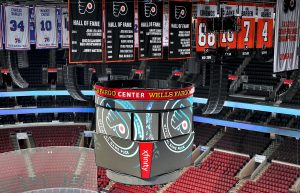Tech Focus: Venue Sound, Part 1 — Louder, Clearer, Bigger (Bottom)
The evolution continues as sports facilities aim to give fans better audio
Story Highlights
Louder, clearer, and bigger bottom. Those have become the key criteria for live sound systems in sports venues in recent years. Louder because venues have become larger and fans in stands have become accustomed to — and often demand — ever-higher SPL for everything from concerts to corporate events. Clearer because consumers have come to expect higher speech intelligibility in the movies, in churches, and at work. And more bottom because both music and entertainment-effects audio — for example, hip-hop and Michael Bay film soundtracks — have extended the low end of the spectrum to the point where a subwoofer in any sound system, commercial or residential, is no longer a luxury but a necessity.
“A game has become a performance production in and of itself,” says Preston Gray, sales manager, U.S., Nexo, a wholly owned subsidiary of Yamaha. “It’s now at the point where the sound has to keep up with lights and the video in the venue. The audio has to support what the fans are seeing.” That, he adds, is also becoming the case in collegiate sports venues and, in a few instances, even some high-end high school stadiums.
Stadiums, Arenas Look Beyond Sports
“Rider-friendly” or “rider-ready” — PA-system brands widely accepted by top-tier touring music artists, who list them on their contract addenda (aka “riders”) — systems have been migrating to the sports-venue industry in the past several years. That’s due in part to the growing use of stadiums and arenas as entertainment venues and is part of a larger trend that has seen high-end sound systems expand beyond touring into the installed-sound market, as brands search for new markets.

The Wells Fargo Center received $250 million in A/V upgrades as part of its “Transformation 2020” initiative, including a new L-Acoustics K2/K1-SB sound system, installed by integrator Diversified.
In recent years, the two leading rider-ready touring brands, d&b audiotechnik and L-Acoustics, have turned to sports in a big way. Based in Germany and France, respectively, the two have most of their sports installations in Europe, but both have also moved assertively into the North American market. For example, d&b audiotechnik systems are installed in Houston’s Rice Stadium, Nashville’s Bridgestone Arena, and Angel Stadium of Anaheim, and L-Acoustics systems are in Tampa’s Amalie Arena, San Antonio’s AT&T Center, and Vancouver’s Rogers Arena.
“Having a PA brand that’s considered rider-friendly can be an advantage for venues that need to attract more entertainment events to fill in between games and matches,” says Marc Lopez, VP, marketing, Americas, d&b audiotechnik. “Consumers may not know the brand names, but they now have expectations about sound quality as a result of hearing certain sound systems at concerts. They want that kind of experience to be seamless between entertainment and sports.”
Thus, he adds, some stadiums and arenas are replacing or augmenting distributed-type PA systems, which many sports venues have turned to because of the enhanced speech intelligibility they provide, an advantage with life-safety issues becoming critical in a post-9/11 environment. The line-array designs of touring sound systems have achieved similar levels of spoken-word intelligibility, as measured by such metrics as STI (Speech Transmission Index) or STIPA (Speech Transmission Index of Public Address Systems).
Modern Problems
John Monitto, director, business development. Meyer Sound, cites some collateral challenges in the shift to bigger, higher-powered sound systems: for example, how to extend the dynamic range of sound systems to ensure that they can clearly and intelligibly convey speech over ever-louder crowd and music noise. He is part of an AVIXA (formerly Infocomm) initiative that’s examining how to achieve optimal peak-to-average levels for speech in these environments without front-of-house mixers’ constantly riding console faders, which can produce uneven level outcomes, or overusing compression, which often cannot keep up with frequent and sudden changes in overall level at sports events.
“Understanding peak-to-average is critical for this,” he explains. “You’ll often have sound mixers who may work only a dozen games in a season and get in the habit of using or overusing compression to ride levels, particularly on new digital consoles that have compression built in. That can result in speech getting squashed and harder to understand. We have to develop new standards around this as stadiums continue to get louder.”
Monitto also notes that the audio content accompanying the content played on stadium and arena video screens can vary widely in relative volume levels and is subject to few industry standards.
More Brands, More Choices
With sports maintaining its position as the largest single live-event moneymaker globally, sports venues are attracting more brands into what had been a relatively narrow market sector. France-based Nexo is a dominant brand in Europe and other overseas markets, but, says Gray, the U.S. market is one that all brands aspire to: “There are more opportunities here now for more brands.”
That phenomenon will likely change the dynamic for sound systems in sports venues. Economically, more brands in the market could produce downward pressure on system pricing. Consequently, the sound in minor-league, second-tier collegiate, and even some high school venues are likely to get in on that.
In terms of system design, more hybrid systems, with line-array or point-source systems used for volume and coverage, are likely to be deployed in conjunction with distributed systems, which provide the best clarity for speech.
“It’s not just sports anymore; it’s entertainment,” says Vance Breshears, director, Idibri, a consultancy whose portfolio includes AT&T Park in San Francisco, Chase Field in Phoenix, and Angel Stadium of Anaheim. “Venues today, from their architecture to their technology systems, are being designed for one thing: the fan experience, the impact on people. In many ways, they’re no different from performing-arts centers, only more demanding.”
CLICK HERE for Tech Focus: Venue Sound, Part 2 — New Builds Focus on Live Sound.
